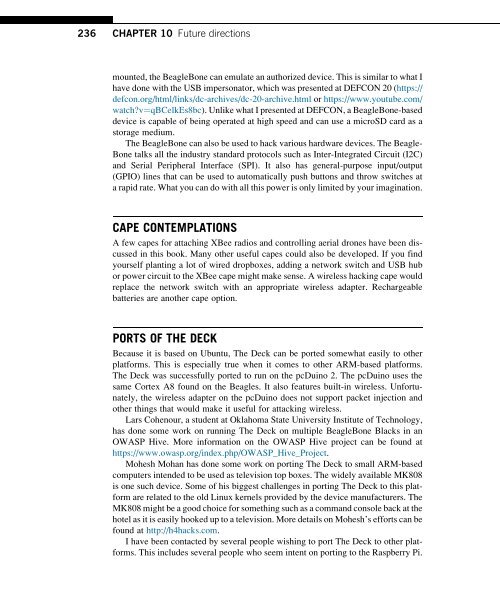Hacking_and_Penetration_Testing_with_Low_Power_Devices
You also want an ePaper? Increase the reach of your titles
YUMPU automatically turns print PDFs into web optimized ePapers that Google loves.
236 CHAPTER 10 Future directions<br />
mounted, the BeagleBone can emulate an authorized device. This is similar to what I<br />
have done <strong>with</strong> the USB impersonator, which was presented at DEFCON 20 (https://<br />
defcon.org/html/links/dc-archives/dc-20-archive.html or https://www.youtube.com/<br />
watch?v¼qBCelkEs8bc). Unlike what I presented at DEFCON, a BeagleBone-based<br />
device is capable of being operated at high speed <strong>and</strong> can use a microSD card as a<br />
storage medium.<br />
The BeagleBone can also be used to hack various hardware devices. The Beagle-<br />
Bone talks all the industry st<strong>and</strong>ard protocols such as Inter-Integrated Circuit (I2C)<br />
<strong>and</strong> Serial Peripheral Interface (SPI). It also has general-purpose input/output<br />
(GPIO) lines that can be used to automatically push buttons <strong>and</strong> throw switches at<br />
a rapid rate. What you can do <strong>with</strong> all this power is only limited by your imagination.<br />
CAPE CONTEMPLATIONS<br />
A few capes for attaching XBee radios <strong>and</strong> controlling aerial drones have been discussed<br />
in this book. Many other useful capes could also be developed. If you find<br />
yourself planting a lot of wired dropboxes, adding a network switch <strong>and</strong> USB hub<br />
or power circuit to the XBee cape might make sense. A wireless hacking cape would<br />
replace the network switch <strong>with</strong> an appropriate wireless adapter. Rechargeable<br />
batteries are another cape option.<br />
PORTS OF THE DECK<br />
Because it is based on Ubuntu, The Deck can be ported somewhat easily to other<br />
platforms. This is especially true when it comes to other ARM-based platforms.<br />
The Deck was successfully ported to run on the pcDuino 2. The pcDuino uses the<br />
same Cortex A8 found on the Beagles. It also features built-in wireless. Unfortunately,<br />
the wireless adapter on the pcDuino does not support packet injection <strong>and</strong><br />
other things that would make it useful for attacking wireless.<br />
Lars Cohenour, a student at Oklahoma State University Institute of Technology,<br />
has done some work on running The Deck on multiple BeagleBone Blacks in an<br />
OWASP Hive. More information on the OWASP Hive project can be found at<br />
https://www.owasp.org/index.php/OWASP_Hive_Project.<br />
Mohesh Mohan has done some work on porting The Deck to small ARM-based<br />
computers intended to be used as television top boxes. The widely available MK808<br />
is one such device. Some of his biggest challenges in porting The Deck to this platform<br />
are related to the old Linux kernels provided by the device manufacturers. The<br />
MK808 might be a good choice for something such as a comm<strong>and</strong> console back at the<br />
hotel as it is easily hooked up to a television. More details on Mohesh’s efforts can be<br />
found at http://h4hacks.com.<br />
I have been contacted by several people wishing to port The Deck to other platforms.<br />
This includes several people who seem intent on porting to the Raspberry Pi.


